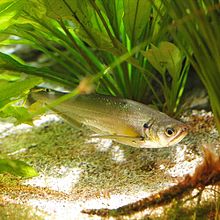| Hydrolycus | |
|---|---|

| |
| Hydrolycus scomberoides | |
|
Scientific classification
| |
| Domain: | Eukaryota |
| Kingdom: | Animalia |
| Phylum: | Chordata |
| Class: | Actinopterygii |
| Order: | Characiformes |
| Family: | Cynodontidae |
| Subfamily: | Cynodontinae |
| Genus: |
Hydrolycus ( J. P. Müller & Troschel, 1844) |
Hydrolycus is a genus of large dogtooth characins from tropical South America, where found in the Amazon and Orinoco basins, as well as rivers of the Guianas. [1] The genus includes the largest dogtooth characins, reaching up to 1.17 m (3.8 ft) in length. [1] They have long, pointed teeth (shorter and less extreme in H. wallacei) used for spearing their prey, generally smaller fish. [2] In a study of the stomachs of 45 individuals, most were empty, but among the remaining the prey fish were 15–50% of the length Hydrolycus itself. [3]
In 1999 two new species were described, the first in this genus in 158 years. [1] [2]
Species

There are currently four described species. [1]
- Hydrolycus armatus ( Jardine, 1841) (Payara)
- Hydrolycus scomberoides ( G. Cuvier, 1819) (Payara)
- Hydrolycus tatauaia Toledo-Piza, Menezes & dos Santos, 1999
- Hydrolycus wallacei Toledo-Piza, Menezes & dos Santos, 1999
References
- ^ a b c d Froese, Rainer and Pauly, Daniel, eds. (2017). Species of Hydrolycus in FishBase. January 2017 version.
- ^ a b Toledo-Piza, M.; N.A. Menezes; G.M. Santos (1999). "Revision of the Neotropical fish genus Hydrolycus (Ostariophysi: Characiformes: Cynodontidae) with the description of two new species". Ichthyol. Explor. Freshwaters. 10 (3): 255–280.
- ^ Goulding, M (1980). The Fishes and the Forest: Explorations in Amazonian Natural History. University of California Press. pp. 185–186. ISBN 0-520-04131-3.